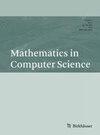智能反射面辅助无线监控系统联合波束形成优化
IF 1
Q2 MATHEMATICS, APPLIED
引用次数: 0
摘要
由大量反射单元组成的智能反射面(IRS)可以通过调节反射单元的相移来增强所需信号和/或抑制不需要的信号。在本文中,我们考虑一个IRS辅助无线监控系统,其中部署IRS协助合法监控接收器E监控可疑链路从AP到可疑接收器b的信息传输,假设可疑链路是否知道监视器的存在,考虑两种通信场景。提出监视器E处可达率大于可疑接收机B处可达率约束下的优化问题,共同优化AP处的波束形成矢量和IRS处的相移矩阵,使可达窃听率最大化。为了解决这一非凸问题,我们引入了半确定松弛(SDR)方法和交替优化(AO)方法,将非凸优化问题转化为一系列半确定规划(SDPs)并迭代求解。仿真结果表明,IRS的辅助能够极大地提高监控性能,与传统的中继辅助无线监控系统相比,具有明显的优势。本文章由计算机程序翻译,如有差异,请以英文原文为准。
Joint Beamforming Optimization for the Intelligent Reflecting Surface Assisted Wireless Surveillance System
The intelligent reflecting surface (IRS), which consists of a large number of reflecting units, can adjust the phase shifts of its reflecting units to strengthen the desired signal and/or suppress the undesired signal. In this paper, we consider an IRS-assisted wireless surveillance system where an IRS is deployed to assist the legal surveillance receiver E to monitor the information transmission of the suspicious link from AP to the suspicious receiver B. Two communication scenarios assuming whether the suspicious link is aware of the existence of the monitor are considered. The optimization problem under the constraint that the achievable rate at the monitor E is larger than that at the suspicious receiver B is proposed to jointly optimize the beamforming vector at the AP and the phase shift matrix at the IRS to maximize the achievable eavesdropping rate. To solve this non-convex problem, we introduce the semi-definite relaxation (SDR) approach and the alternating optimization (AO) method to convert the non-convex optimization problem to a series of semi-definite programs (SDPs) and solve the SDPs iteratively. Simulation results show that the assistance of IRS can greatly improve the performance of the surveillance, and achieves significant advantages over the traditional relay-assisted wireless surveillance system.
求助全文
通过发布文献求助,成功后即可免费获取论文全文。
去求助
来源期刊

Mathematics in Computer Science
MATHEMATICS, APPLIED-
CiteScore
1.40
自引率
12.50%
发文量
23
期刊介绍:
Mathematics in Computer Science publishes high-quality original research papers on the development of theories and methods for computer and information sciences, the design, implementation, and analysis of algorithms and software tools for mathematical computation and reasoning, and the integration of mathematics and computer science for scientific and engineering applications. Insightful survey articles may be submitted for publication by invitation. As one of its distinct features, the journal publishes mainly special issues on carefully selected topics, reflecting the trends of research and development in the broad area of mathematics in computer science. Submission of proposals for special issues is welcome.
 求助内容:
求助内容: 应助结果提醒方式:
应助结果提醒方式:


